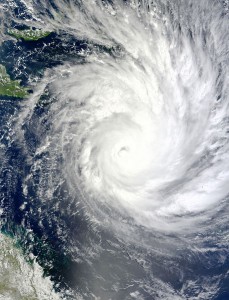Australia Disasters Costliest Ever
 Australia suffered the costliest natural disasters in the country’s history in January and claims resulting from devastation caused by catastrophic floods and Cyclone Yasi [pictured intensifying as it approached the country on Feb. 1] will be “an ongoing challenge” for global re/insurers for months to come, leading industry analysts say today [Feb. 4].
Australia suffered the costliest natural disasters in the country’s history in January and claims resulting from devastation caused by catastrophic floods and Cyclone Yasi [pictured intensifying as it approached the country on Feb. 1] will be “an ongoing challenge” for global re/insurers for months to come, leading industry analysts say today [Feb. 4].
Bermuda, a global leader in the property catastrophe re/insurance market, will absorb a significant portion of the insured losses stemming from the flooding which began in December and this week’s storm. Both global financial services company Barclays and catastrophe re/insurance analysts expect the Queensland disasters will significantly impact on both 2010 and 2011 earnings for Bermuda firms.
Earlier this week leading Bermuda re/insurer Partner Re said it expected to absorb losses of between $25 and $35 million from the December flooding alone.
US catastrophe modelling firm AIR Worldwide estimates insured losses from Cyclone Yasi — the worst storm to hit Australia since 1918 — at between $354 million and $1.5 billion.
And Aon Benfield, the global reinsurance intermediary and capital advisor of Aon Corporation, says even excluding damages caused by Yasi, Australia suffered its costliest natural disaster in history, with several weeks of severe flooding that has already resulted in $5.65 billion in economic damages.
The total cost of repairing and rebuilding could potentially push the overall economic losses between $10.1 and $20.2 billion.
Waves of heavy rains — primarily in Queensland — resulted in a deluge that killed as many as 36 people and caused extensive damage to property and infrastructure in hundreds of cities, towns and villages. Three quarters of Queensland was declared a disaster area at one point.
The Insurance Council of Australia declared four separate catastrophes during the floods, with combined preliminary insured losses in Queensland and Victoria totaling $1.58 billion and more than 43,240 claims filed.
Steve Jakubowski, Aon Benfield’s president of impact forecasting, said: “This natural disaster has been absolutely devastating to Australia, not only at a personal level, where millions of people have been affected and thousands left homeless, but also at an economic level.
“It is estimated that dozens of mines in Queensland have been hit by the floods, and will not be restored to full capacity for possibly several months. The assessment of this cost from a business interruption perspective will be an ongoing challenge for the re/insurance industry.”
Meanwhile, Aon Benfield said the most deadly natural disaster in Brazilian history also occurred in January following a series of massive mudslides in the Serrano mountain region.
The states of Sao Paolo and Rio de Janeiro were most affected, with 856 deaths and hundreds of people still missing. According to government figures, more than 21,500 homes, businesses and other structures were destroyed, with total economic losses estimated at $1.2 billion.
Continuing its review of global catastrophes, Aon Benfield said major winter storms in the US continued to affect the eastern half of the country during January. Multiple storm systems brought additional rounds of record snow to New England and the Mid-Atlantic States, while record cold spells affected areas across the Southeast.
In Asia, floods and landslides hit Sri Lanka and the Philippines. The latter suffered consecutive weeks of heavy rain across 25 separate provinces, killing at least 75 people. According to the National Disaster Coordinating Council, at least 5,729 homes were damaged or destroyed along with crops and infrastructure, and total economic losses reached $46.4 million.
In Sri Lanka, at least 43 people died in floods that inundated four provinces. According to the National Disaster Management Center, at least 50,000 homes, businesses and other structures were damaged along with vast areas of rice fields. Total economic losses were listed at $500 million.
In China, severe winter weather affected the south and east of the country, killing at least two people, causing an economic loss of $1.7 billion, and destroying more than 150,000 homes.
Meanwhile, Europe witnessed flooding across parts of Germany, Poland and the Czech Republic, affecting thousands of people, homes, businesses and infrastructure.
In Africa, at least 136 people died as flooding submerged agricultural land across parts of South Africa, Mozambique, Botswana, Namibia, Zambia and Zimbabwe. In South Africa, the total economic losses to property and agriculture were listed at $495 million,

